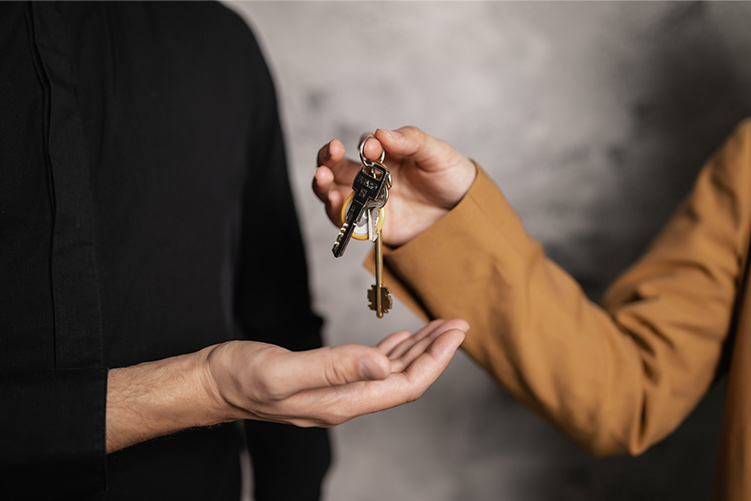Leasehold mortgages
Getting a mortgage on a Leasehold property
Owning a leasehold flat is becoming more and more popular in the UK, with over 4.8 million leasehold properties. It offers buyers the opportunity to live in more central locations at more affordable prices.
While leasehold flats can make a great home or investment, it’s always worth doing your due diligence when buying one because they do come with their drawbacks and can sometimes present challenges when getting a mortgage, this guide explains the key points to consider when getting a mortgage on a leasehold flat.
What is a Lease hold property?
A leasehold property refers to a type of property ownership where an individual holds a lease agreement with the freeholder or landlord. In this arrangement, the leaseholder has the right to occupy and use the property for a specified period, typically long-term, but does not own the land on which the property stands.
Leasehold properties are commonly found in the context of flats or apartments, where multiple units share a building. The leaseholder may have certain responsibilities and obligations, such as paying ground rent and service charges. At the end of the lease term, ownership of the property typically reverts back to the freeholder, unless a lease extension or enfranchisement process is pursued.
What is the difference between leasehold and freehold?
The main difference between leasehold and freehold is the extent of ownership and control over the property.
Freehold: When you own a property freehold, you have complete ownership of both the property and the land it stands on. You have the right to use, occupy, and modify the property as you see fit, within the boundaries of local regulations. You have no time limit on your ownership, and it is passed on to your heirs.
Leasehold: With a leasehold property, you own the right to occupy and use the property for a specific period of time as stipulated in the lease agreement. However, you do not own the land itself. The land is owned by the freeholder or landlord. The leasehold period can vary, typically ranging from 99 years to 125 years, although shorter leases are also possible. At the end of the lease term, the property reverts back to the freeholder unless lease extension or enfranchisement is pursued.
Can I get a mortgage on a leasehold property?
Yes, it is possible to obtain a mortgage on a leasehold property. Lenders generally provide mortgages for leasehold properties, although they may have specific criteria and considerations, such as the length of the lease remaining and the ground rent and service charges associated with the property.
Eligibility criteria for a leasehold flat
When it comes to obtaining a mortgage for a leasehold flat, there are various eligibility criteria that lenders may consider. Here are a few common factors that lenders may take into account:
– Lease length: Lenders typically prefer leasehold properties with a longer remaining lease term. While some lenders may accept leases with as little as 60 years remaining, others may require a minimum of 85 years.
– Loan-to-value (LTV) ratio: Lenders may have restrictions on the maximum LTV they are willing to offer for leasehold flats. While it’s possible to get a mortgage with a high LTV ratio (e.g., 95%), some lenders may cap it at a lower percentage, such as 85%.
– Property type: Certain lenders may have restrictions on lending for specific types of leasehold properties. For example, they may be hesitant to lend on properties in high-rise buildings, flats above commercial premises, small studio flats, or those owned by local authorities.
– Ground rent: Lenders typically assess the ground rent associated with the leasehold property. They may have restrictions on ground rent that doubles too quickly or frequently, such as every 10 or 15 years. Excessive ground rent escalation can affect affordability and potentially impact the property’s resale value.
– Service charge: Lenders also take into account the service charge associated with the leasehold property. This fee covers the maintenance and management of communal areas and services. The service charge is factored into the borrower’s affordability assessment to ensure they can comfortably meet their mortgage repayments along with the ongoing service charge payments.
Leasehold properties come with both pros and cons. Here are some of the main advantages and disadvantages:
Pros of Leasehold Properties:
– Affordability: Leasehold properties often have a lower upfront cost compared to freehold properties, making them more affordable for buyers.
– Central Locations: Leasehold properties are typically found in more central and desirable locations, offering convenient access to amenities, transportation, and urban facilities.
– Maintenance and Repairs: The responsibility for certain maintenance and repairs, such as structural issues or communal areas, often lies with the freeholder or management company, relieving the leaseholder of some maintenance burdens.
– Shared Costs: Service charges and maintenance fees are shared among the leaseholders, reducing individual financial burdens for common areas and shared amenities.
Cons of Leasehold Properties:
– Lease Length and Ground Rent: The lease length can decrease over time, potentially affecting the property’s resale value. Additionally, increasing ground rent can impact affordability and long-term ownership costs.
– Lack of Control: Leasehold properties grant limited control and flexibility to leaseholders. There may be restrictions on alterations, subletting, or pets, subject to the terms of the lease.
– Service Charge Increases: Leaseholders may experience periodic increases in service charges, which could impact their ongoing financial commitments.
– Lease Extension and Enfranchisement: Extending the lease or purchasing the freehold can involve additional costs and complex legal processes.
Why do mortgage lenders check the term of a lease?
Mortgage lenders check the remaining years on the lease to assess the risk associated with the leasehold property. The length of the lease term directly affects the property’s value, marketability, and the likelihood of future issues.
Lenders want to ensure that the property will retain its value over the loan term, as a property with a short lease term may have limited market appeal and may be difficult to sell or repossess in case of default. Additionally, lenders want to ensure that there is sufficient time remaining on the lease for the borrower to repay the mortgage and that they won’t face potential complications or costs associated with lease extensions or renewals in the near future.
What is the minimum lease length for a mortgage?
The minimum lease term required by lenders to approve a mortgage can vary. While some lenders may have a minimum requirement of 85 years remaining on the lease at the time of application, others may consider lease terms as low as 60 or even 55 years remaining at the end of the lease term.
It’s worth noting that having a shorter lease term may limit the number of lenders willing to offer a mortgage, and the terms and conditions of the mortgage may vary as well. In such cases, it is advisable to seek advice from mortgage brokers or consult with multiple lenders to explore available options based on your specific lease term.
Is rising ground rent a problem?
Yes, rising ground rent can indeed pose challenges when obtaining a mortgage. Lenders have varying criteria regarding ground rent increases, especially when it involves rapid doubling within short periods, such as every 5, 10, or 15 years. Many lenders are cautious about these types of clauses as they can significantly impact the affordability of the property in the long term.
However, lenders typically consider ground rent increases that are established and reasonable. They may accept periodic rises that are within certain thresholds, such as an annual ground rent that is below a certain percentage of the property value or a longer interval for ground rent doubling.
What if the lease length is too short?
Yes, if the lease length is deemed too short by lenders to obtain a mortgage, there are options available to address this issue:
– Request Lease Extension: As part of the purchase transaction, you can negotiate with the seller to extend the lease. If the seller agrees, they may use the proceeds from the sale to cover the cost of the lease extension. This can be a mutually beneficial arrangement, as it increases the marketability and value of the property.
– Self-Funded Lease Extension: If the seller is unwilling or unable to extend the lease, you can explore the option of self-funding the lease extension. This involves contacting the freeholder or landlord and initiating the lease extension process. However, it’s important to note that self-funding the lease extension can be costly, as you would be responsible for covering the associated expenses, such as the premium and legal fees.
How much does a lease extension cost?
The cost of a lease extension can vary depending on various factors, including the property’s value, remaining lease term, ground rent, and location. The specific terms negotiated between the leaseholder and the freeholder or landlord also play a significant role in determining the cost.
Lease extension costs typically consist of two main components:
– Premium: The premium is the price paid to the freeholder or landlord for extending the lease. It is based on the property’s value and the number of years added to the lease term. A professional valuer or surveyor is usually involved in determining the premium.
– Legal and Professional Fees: In addition to the premium, there are legal and professional fees associated with the lease extension process. These include solicitor’s fees, surveyor’s fees, valuation fees, and potentially the freeholder’s legal costs.
As lease extension costs can vary significantly, it is recommended to consult with a qualified surveyor and seek legal advice to get an accurate estimate based on your specific circumstances. They can provide you with a detailed breakdown of the expected costs and guide you through the lease extension process.
What questions to ask when buying a leasehold flat?
When buying a leasehold flat, it’s important to ask pertinent questions to gather essential information. Here are some key questions to consider:
1. Lease Length: How many years are remaining on the lease? Does it meet the minimum requirements of lenders for obtaining a mortgage?
2. Ground Rent: What is the current ground rent, and does it increase over time? If so, how frequently and by what amount?
3. Service Charges: What are the service charges associated with the property? What services and maintenance are covered by the charges? Are there any anticipated increases in service charges?
4. Lease Restrictions: Are there any restrictions in the lease, such as limitations on pets, alterations, or subletting? Understand the implications of these restrictions on your intended use of the property.
5. Management and Maintenance: Who is responsible for managing and maintaining the building and communal areas? Is there a management company or a residents’ association?
6. Insurance: Is building insurance provided, and if so, what does it cover? Do you need additional contents insurance?
7. Major Works: Are there any planned or ongoing major works or renovations in the building? If so, how are the costs shared among leaseholders?
8. Lease Extension and Enfranchisement: Is it possible to extend the lease or purchase the freehold? If applicable, inquire about the process, costs involved, and the rights of leaseholders.
Are freehold rates different to leasehold rates?
Generally, freehold and leasehold mortgage rates do not differ significantly. Lenders typically offer the same mortgage products and interest rates for both types of properties. However, there can be some variations in lending criteria and deposit requirements, which may indirectly affect the available mortgage options and rates.
Can I get a mortgage on a leasehold flat with a 5% deposit?
Yes, it is possible to get a mortgage on a leasehold flat with a 5% deposit. However, it’s important to note that not all lenders offer mortgages with a 5% deposit, and some may have specific requirements or restrictions for leasehold properties.
Some Lerner’s require a deposit of 10% or 15% of the property’s value. Larger deposits may be required on new builds of Buy to Let Mortgages. These requirements may vary depending on the lender and the specific circumstances of the property.
Speak To an Expert
Whether you’ve just had an offer accepted on a property and you’re ready to go, or you’re simply wondering how much you need to save for a deposit, it’s never too soon to reach out.
Can I get a mortgage on a flat above a shop?
Yes, it is possible to get a mortgage on a flat above a shop, but it depends on the lender and various factors related to the commercial outlet. Lenders may have specific criteria and considerations when assessing mortgage applications for flats above shops.
Some factors that lenders may take into account include:
– Commercial Outlet Type: The type of commercial outlet below the flat can affect the mortgage eligibility. Lenders may have different views on the acceptability of certain types of businesses, such as those that serve alcohol or operate late at night.
– Deposit: Lenders may require a larger deposit for flats above shops compared to other types of properties. This is because they may perceive such properties as higher risk due to potential noise, smell pollution, or other factors associated with commercial activities.
– Potential Hazards: Lenders may assess the property for potential hazards, such as fire risks, noise pollution, or odor issues, associated with the commercial operations. Properties with higher risks may face more stringent requirements or higher interest rates.
It’s important to note that each lender has its own policies and criteria, so it’s advisable to consult with mortgage brokers or directly approach lenders experienced in financing flats above shops.
How to improve your chances of getting a leasehold mortgage?
To improve your chances of getting a leasehold mortgage, you can take the following steps:
– Work with a Mortgage Broker: Engage the services of a mortgage broker who specializes in leasehold properties. They have access to a wide range of lenders and can help you find mortgage options that best suit your circumstances.
– Larger Deposit: Increasing your deposit amount can strengthen your mortgage application. Lenders may have specific requirements for leasehold properties and may be more inclined to offer favorable terms if you have a larger deposit.
– Maintain a Good Credit Score: A strong credit score enhances your eligibility for a mortgage. Ensure that you have a good credit history, pay bills on time, and manage your debts responsibly.
– Property Type Considerations: Be aware of specific lender criteria regarding property types such as high-rise buildings, ex-local authority properties, studio flats, or flats above commercial premises. Some lenders may have restrictions or require additional scrutiny for these types of properties.
For more info on leasehold mortgages, please contact a member of the Strive team, by emailing info@strivemortgages.co.uk or call us on 01273 002697.




